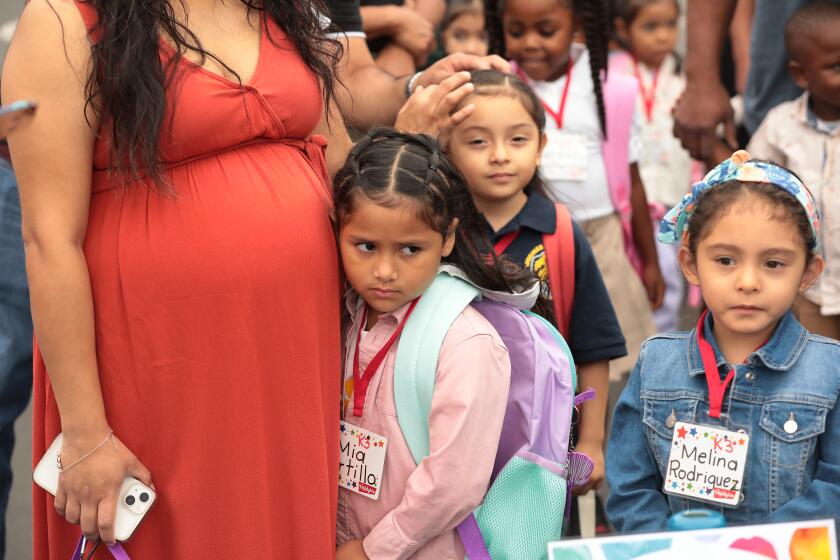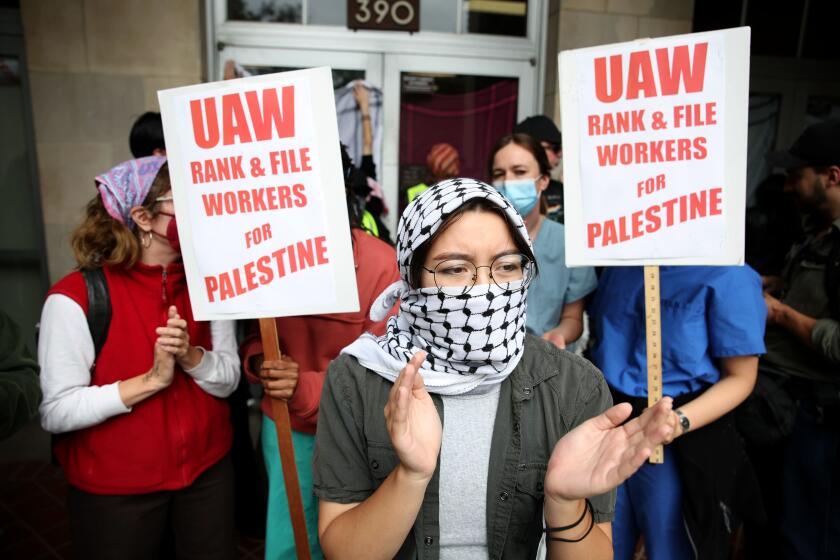UNIVERSITY PARK : Family Moves Into Project’s Latest Home
Until last week, the Miranda family of four had slept in the same room.
Their modest one-bedroom apartment on 29th Street allowed only 1 1/2 feet between the parents’ queen-size bed and the crib and single bed of their daughters, ages 2 and 8.
“It’s hard,” Maria, 28, said as she packed her family’s belongings days before the move. “We don’t have any privacy and the room is very small.”
But on Tuesday that all changed when Mario and Maria Miranda moved their family into a new three-bedroom house built in cooperation with Habitat for Humanity, USC and the Seal Beach-based Koll Construction Co.
“I want to hug everybody for everything they did,” a tearful Maria said as she stood in the kitchen of her new 1,100-square-foot home after a dedication ceremony filled with a feeling of volunteerism, gratitude and gifts. “I’m probably going to cry all day.”
The Mirandas’ house on 24th Street is the ninth house in the Los Angeles area built since 1992 by Habitat for Humanity, a nonprofit agency started by former President Jimmy Carter that constructs homes nationwide for low-income families.
The one-story house with a large front porch and French doors also represents the fruits of a two-year effort between USC and Habitat. The partnership began after a group of graduate students persuaded Bonnie Holmes, an administrator with the USC School of Urban and Regional Planning, to become involved.
Impressed with the program, Holmes and graduate student Jim Schuemaker, also a Habitat volunteer, decided to pitch the idea that the university and the agency join in building a house.
Holmes reasoned that the arrangement would provide practical instruction for urban planning students and “do some good at the same time.”
In the end, USC not only donated $20,000 to help buy the land but also created a class to study the workings of the project and help build the house.
Los Angeles Trade Technical College also supplied volunteers and the Koll company contributed more than $80,000 in labor and construction materials.
In the summer of 1993, the university launched the search for the family to occupy the house, sending out 250 applications to low-income employees.
The Mirandas were chosen from 125 respondents because they met Habitat’s main criteria that they live in a crowded home, earn considerably less than the median income for the region and have steady jobs, Holmes said.
Mario is a self-employed auto detailer and Maria has worked at the USC Early Childhood Education School for six years. Together they bring home about $22,000 a year.
Last June, the Mirandas received two phone messages--one day apart--from coordinators with the project. “I didn’t want to return the call because I was afraid they we’re going to say sorry, we didn’t get the house.”
When she finally mustered enough courage to call, however, the news was just the opposite. “I was so excited I was acting like a kid jumping up and down,” she said.
In return, the Mirandas agreed to volunteer 500 hours to help Habitat construct their home and three other homes and to work in the agency’s office.
For the next 20 years, the Mirandas will pay Habitat, which owns the property, a monthly mortgage payment of about $370--$180 cheaper than the rent at their apartment. Organizers estimated the house’s market value at $130,000.
More to Read
Start your day right
Sign up for Essential California for news, features and recommendations from the L.A. Times and beyond in your inbox six days a week.
You may occasionally receive promotional content from the Los Angeles Times.






